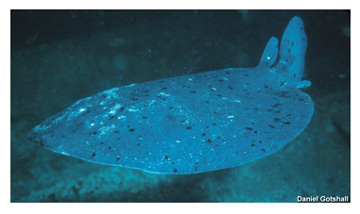Radio Program
Our regular Science and the SeaTM radio program presents marine science topics in an engaging two-minute story format. Our script writers gather ideas for the radio program from the University of Texas Marine Science Institute's researchers and from our very popular college class, Introduction to Oceanography, which we teach to hundreds of non-science majors at The University of Texas at Austin every year. Our radio programs are distributed at to commercial and public radio stations across the country.
Hurricane experts are predicting a busy season this year. And that could mean bigger-than-usual “red tides” later on.
A red tide is a “bloom” of algae in coastal waters. Some blooms are harmless. But some contain a species of algae that produces toxins that can kill fish and birds and harm people.
Currents of warm, salty water flow from the Mediterranean Sea into the Atlantic Ocean. Their high salt content makes the currents denser, so when they enter the Atlantic, they sink and form big eddies that spin at depths of more than half a mile. Called “meddies,” they help drive ocean currents that help keep Europe relatively warm.
{mosimage}
Currents of warm, salty water flow from the Mediterranean Sea into the Atlantic Ocean. Their high salt content makes the currents denser, so when they enter the Atlantic, they sink and form big eddies that spin at depths of more than half a mile. Called “meddies,” they help drive ocean currents that help keep Europe relatively warm.
Greenland is one of the least green spots on the planet. It’s a slab of rock covered with ice. In recent years, though, its ice cap has been shrinking. It’s been losing huge amounts of ice each year, as ice melts during the summer, but isn’t replenished during the winter.
{mosimage}
Greenland is one of the least green spots on the planet. It’s a slab of rock covered with ice. In recent years, though, its ice cap has been shrinking. It’s been losing huge amounts of ice each year, as ice melts during the summer, but isn’t replenished during the winter.
A scallop’s best friend just might be a big shark.
{mosimage}
A recent study concluded that the lack of big sharks is helping wipe out beds of bay scallops along the East Coast. The study shows once again that weakening one link of the global food chain can have an impact on the others.
A scallop’s best friend just might be a big shark.
A recent study concluded that the lack of big sharks is helping wipe out beds of bay scallops along the East Coast. The study shows once again that weakening one link of the global food chain can have an impact on the others.
If the weather in your part of the country was wetter than normal last winter, blame it on El Niño. If it was drier than normal -- or colder, or warmer, or windier -- well, blame El Niño.
When a fish known as Torpedo californica locates its prey, it glides in slowly. When it’s within a few inches, it lunges, enfolds the prey like a tortilla wrapping around a piece of skirt steak, then stuns it with an electric shock of up to 50 volts.

If you dive a few hundred feet into any ocean and shine a flashlight into the dark, chances are you’ll see a flurry of small flakes all around you. The flakes are known as “marine snow.” They’re not flakes of frozen water, though, but slimy clumps of small organisms and other matter that are falling toward the ocean floor. They’re an important source of energy for life at greater depths, and they help reduce global warming.


